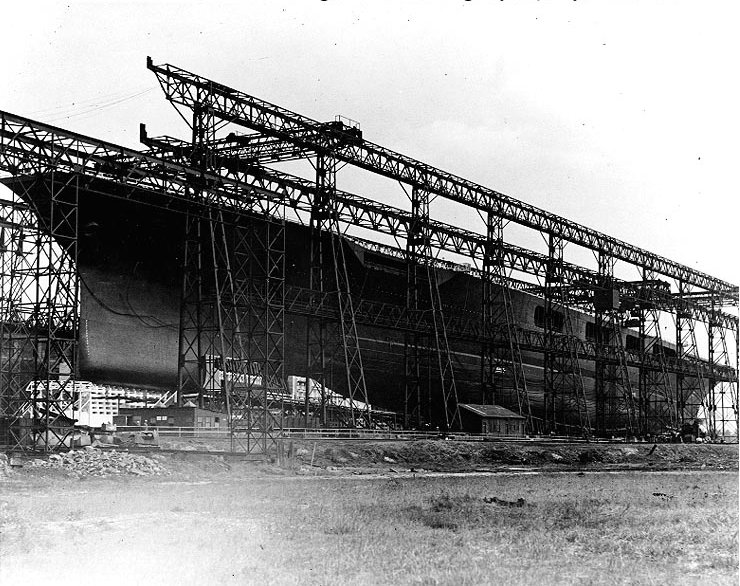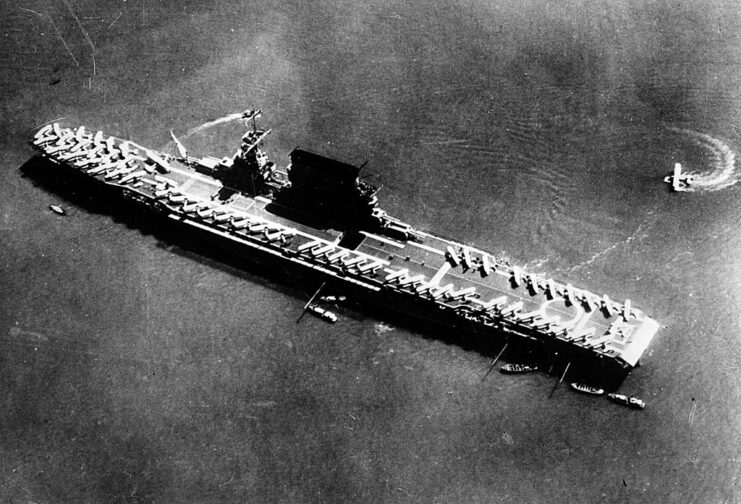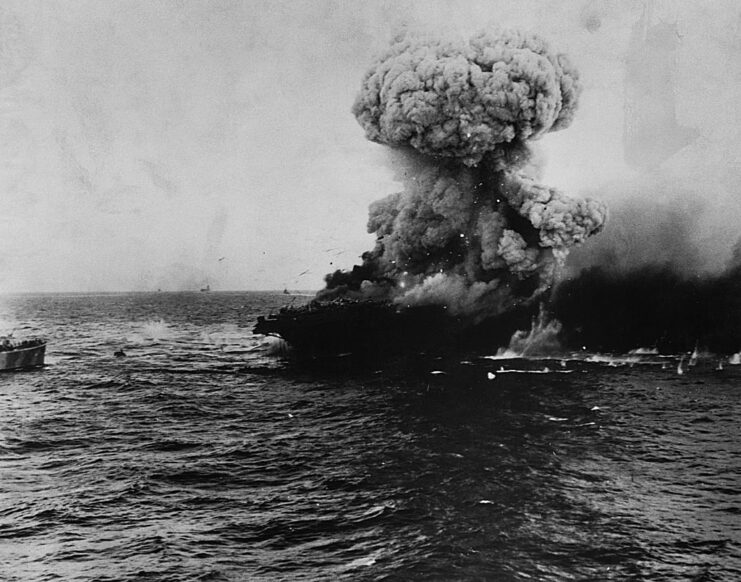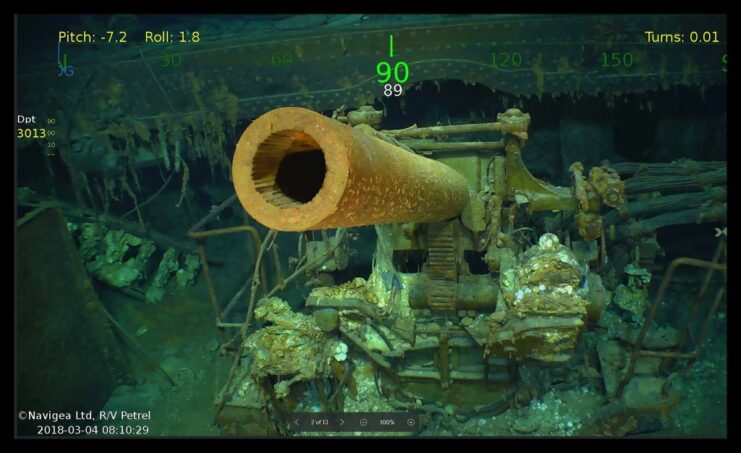The sinking of the USS Lexington (CV-2) was one of many to occur during the Second World War, and her wreck has remained on the seafloor for over 75 years. Assigned to the Pacific Fleet, the US Navy aircraft carrier participated in a number of battles during the conflict – that is, until she was severely damaged by Japanese action during the Battle of the Coral Sea. To prevent Lexington from being commandeered by the enemy, the decision was made to scuttle her.
USS Lexington (CV-2)

The USS Lexington was ordered as a battlecruiser in 1916, but this changed with the signing of the Washington Naval Treaty in 1922, which prevented the construction of battleships of this kind. The decision was subsequently made to transform the design into one of the US Navy’s earliest aircraft carriers. She was commissioned on December 14, 1927, and nicknamed “Lady Lex.”
As Lexington was built outside of wartime, she had many different uses. The Navy used her to create and refine carrier tactics, including staging fake attacks on Pearl Harbor. The vessel also helped the public. During the drought in Tacoma, Washington in 1929-30, her power system was used to supplement that of the city. Lexington also delivered medical supplies and personnel following the 1931 earthquake in Managua, Nicaragua.
The USS Lexington‘s (CV-2) service during World War II

When the Japanese attacked Pearl Harbor on December 7, 1941, the USS Lexington was in the middle of delivering fighter aircraft to Midway Island. She was quickly recalled to base, with her first mission of World War II being an attack on the Japanese in the Marshall Islands, to divert attention from the siege on Wake Island. However, the US sailors and Marines surrendered before any show of force was needed.
At the beginning of 1942, she was sent to the Coral Sea, where she spent the majority of her remaining service. Lexington was used to block the Japanese from advancing in the area, and, along with USS Yorktown (CV-5), attacked several enemy shipping vessels near New Guinea.
Following a refit at Pearl Harbor, she returned to the Coral Sea that May. Her arrival couldn’t have come at a better time, as the Japanese launched Operation Mo only a few days later.
Battle of the Coral Sea

The beginning of Operation Mo marked the start of the Battle of the Coral Sea. The USS Lexington, Yorktown and their carrier aircraft defended the area from the attacking Japanese vessels, having intercepted their plans to take Port Moresby. It was a unique engagement, as historians recount it was the first sea battle where the combatant ships didn’t come within range of each other. Instead, they fought using their carrier aircraft.
On May 7, 1942, Lexington’s aerial fleet sunk the Japanese light aircraft carrier Shōhō. They dropped bombs and torpedos on her, first setting fire to the aircraft on her flight deck, then knocking out her power and steering. Once disabled, the attack continued, and Shōhō started to flood. With the help of Yorktown’s aircraft, the carrier finally sank at 11:31 AM, with Lt. Cmdr. Robert E. Dixon famously calling, “Scratch one flat top!”
A turn for the worse

Unfortunately for the USS Lexington, it didn’t take long for news of her success to reach the nearby Japanese fleet, leading Rear Adm. Chūichi “King Kong” Hara to order his aircraft to retaliate. This move was largely unsuccessful, as the Americans shot down several of the aircraft.
The fighting started up again at around 9:00 AM on May 8, 1942. Although the Americans generally outflew the incoming Japanese bombers, enough Nakajima B5Ns hit Lexington with two torpedo bombs on her port side to cause the ship to slowly flood. A group of 19 Aichi D3As were next to break through and drop three bombs, one of which set off everything in the port forward ammunition locker.
Wreck of the USS Lexington (CV-2)

Over the coming hours, the attacks continued against the USS Lexington. Remarkably, she was still able to refuel many of her aircraft. By 2:42 PM, however, another explosion stopped all power to the front of the ship, and the fires onboard the carrier got worse. Capt. Frederick Sherman ordered the crew to abandon ship at 5:07 PM, ensuring everyone who could was evacuated before he did the same at 6:30 PM.
The decision was made for Lexington to be scuttled, to prevent the Japanese from getting their hands on the vessel. The USS Phelps (DD-360) was tasked with firing five torpedos in her direction. They all hit, sinking the aircraft carrier and 35 of her aircraft.
The majority of her crew were able to escape, with reports indicating that 2,735 were evacuated, while 216 were killed. Despite the losses, the defensive stance made by the USS Yorktown and Lexington was significant, as it prevented the Japanese carriers from reaching New Guinea and Australia, meaning they weren’t able to participate in the Battle of Midway.
The wreck of the USS Lexington (CV-2) is discovered near Australia

A location was recorded for where the USS Lexington (CV-2) was scuttled, but it wasn’t until March 4, 2018 that her final resting place was discovered, after six months of searching.
A research team put together by Paul Allen, co-founder of Microsoft, set out on the research vessel Petrel to try and locate the wreck. They found it over 800 km from the coast of Queensland, Australia, at a depth of 3,000 m.
More from us: Two Aircraft Carriers Were Stationed In the Great Lakes During WWII
Are you a fan of all things ships and submarines? If so, subscribe to our Daily Warships newsletter!
The team confirmed it was the right ship by deploying a remotely-operated underwater vehicle (ROV), which transmitted video feedback to Petrel. The ROV located the nameplate on the wreck’s stern, and found Lexington had broken into several pieces, which rested together. The crew also located 11 of the aircraft – three Douglas SBD Dauntless, seven TBD Devastators and one Grumman F4F Wildcat – nearby.
